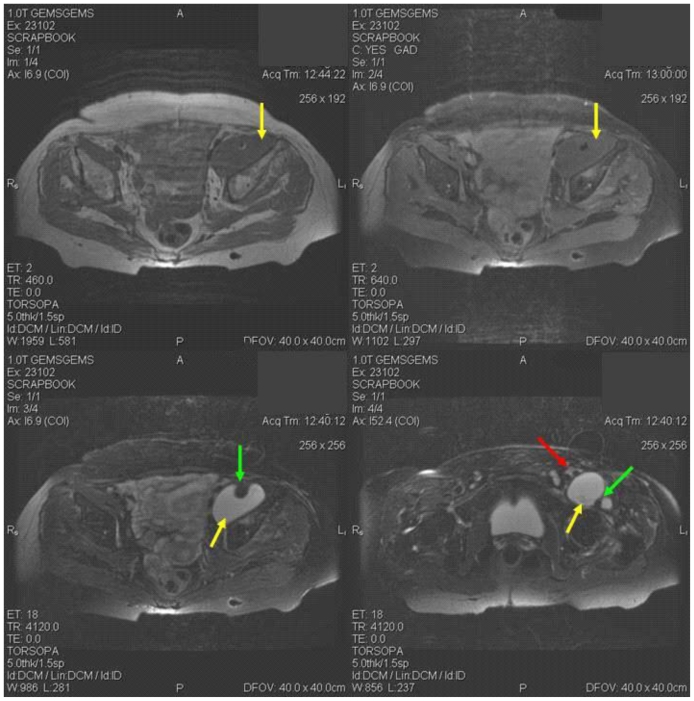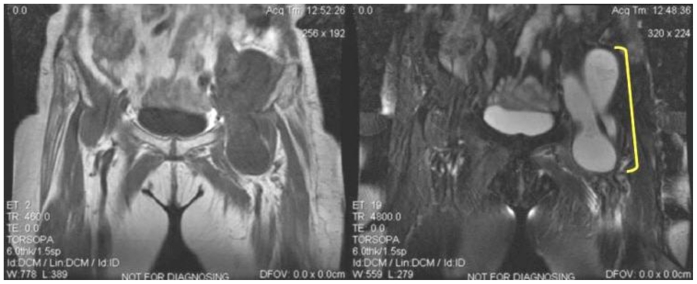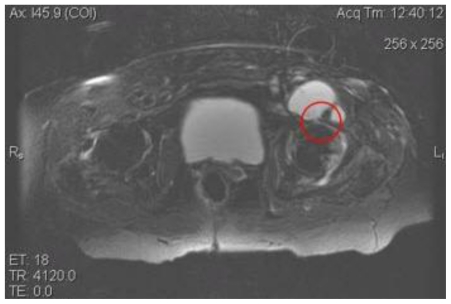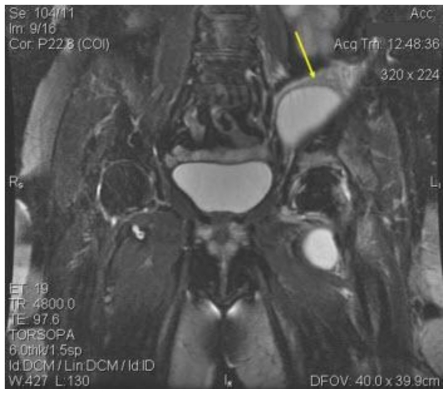Abstract
The authors present an unusual case of atypical iliopsoas bursitis in an 81 years-old female patient. The patient asked for medical advice due to a chronic left hip and lower abdominal pain with no specific characteristics. Physical examination revealed a palpable left-sided pelvic mass. Ultrasound examination demonstrated a purely cystic mass that was presumed to be an ovarian cystic malignancy. The patient was referred for an MRI examination, which showed a cystic lesion extending from the left iliac crest to the anterior aspect of the ipsilateral hip joint (maximum diameter 18 cm), coursing below the iliopsoas tendon indicative of an extremely distended iliopsoas bursa.
Keywords: Iliopsoas bursa, iliopsoas bursitis, hip joint
CASE REPORT
An 81-year-old female patient presented to our department for an MRI examination due to dull chronic lower abdominal pain and a painful left hip joint. Physical examination revealed a palpable mass at the left side of the lower abdomen and an abdominal ultrasound examination (performed elsewhere) demonstrated a cystic lesion respectively, which was presumed to represent a cystic mass of the ipsilateral ovary. The patient was afebrile and laboratory findings (complete blood count, biochemical analysis, tumor markers and inflammatory markers) were unremarkable, except findings consistent with mild ferropenic anemia. Patient’s medical and family history was also free (patient suffered only from mild arterial hypertension and was under proper medication). The patient was referred for an MRI examination of the hips and pelvis.
MRI examination revealed a thin-walled purely cystic lesion (with homogenously low signal in T1-weighted sequences and high signal in T2-weighted sequences) measuring 18×7.3×8.5 cm at the left side of the pelvis extending from the left iliac crest to the anterior aspect of the ipsilateral hip joint coursing below the iliacus muscle and iliopsoas tendon (Fig 1a–d, 2). Communication of the lesion with the hip joint was also demonstrated (Fig 3). Imaging findings were strongly indicative of an extremely distended iliopsoas bursa. Degenerative lesions of the left hip joint, including narrowing of joint space and sclerosis with bone marrow edema at the acetabulum were also present (Fig 4). Small joint effusions were apparent bilaterally and after contrast agent injection (20 ml of gadolinium chelate) no enhancement of the cystic lesion was noticed. Mild synovial enhancement was demonstrated at the left hip joint. Aspiration of joint fluid was performed initially as a therapeutic intervention and its culture was sterile.
Figure 1.
81 years-old female patient with atypical iliopsoas bursitis. T1 weighted axial image (a), T1 weighted axial contrast enhanced image (20 ml gadolinium was injected) with fat suppression (b) and T2 axial weighted image (c) at the level of the lower pelvis and T2 weighted axial image at the level of the hip joint demonstrating a non-enhancing cystic lesion (yellow arrow) lying in the left iliac fossa coursing at a lower level below the iliopsoas tendon (green arrow). At the level of the hip joint the cystic lesion (yellow arrow) is demonstrated coursing below the iliopsoas tendon and totally encasing it (green arrow). Femoral vessels are also shown (red arrow).
Figure 2.
81 years-old female patient with atypical iliopsoas bursitis. T1 weighted (a) and T2 weighted (b) coronal images at the level of the cystic lesion demonstrating it’s cephalad extension (yellow bracket).
Figure 3.
81 years-old female patient with atypical iliopsoas bursitis. T2 weighted axial image at the level of the left hip joint. Communication of the cystic lesion with the left hip joint is illustrated (red circle).
Figure 4.
81 years-old female patient with atypical iliopsoas bursitis. T2 weighted coronal image at the level of the hip joints demonstrates degenerative lesions of the left hip joint, including narrowing of joint space as well as sclerosis and bone marrow edema of the acetabulum. High signal intensity is also present at the ipsilateral iliacus muscle (yellow arrow) just above the distended iliopsoas bursa. Small joint effusion and part of the distended iliopsoas bursa are also apparent at the left hip joint.
DISCUSSION
Bursae are generally flattened sacs that serve as a protective buffer between bones and overlapping muscles or tendons. Normally they are in a collapsed state and are only distended and visualized when they are inflamed or infected. The iliopsoas bursa is the largest bursa in the body and lies between the iliacus muscle & iliopsoas tendon and the anterior surface of hip joint capsule (which is also the thinnest part of joint capsule) and pectineal eminence (1). It is present bilaterally in 98% of adults and it may approach 3–7 cm in length and 2–4 cm in width (1,2).
Iliopsoas bursitis is often associated with hip joint pathologies (mostly degenerative and in a lesser degree inflammatory arthropathies), snapping hip syndrome or may appear as a result of repetitive trauma or sport activities in normal hip joints (3).
Synovial chondromatosis and femoral head avascular necrosis have also been reported as possible rare causes (1). In the majority of cases a long-standing hip disorder is present. Osteoarthritic changes are the commonest cause of iliopsoas bursitis. Iliopsoas bursa and hip joint communicate in 15% of normal individuals and almost always in symptomatic cases (1, 4). Various theories have been proposed in order to explain the causative relation of hip pathology and iliopsoas bursitis, such as a) overproduction of fluid in a pathologic hip joint and protrusion of synovium in the iliopsoas bursa, b) via direct communication of iliopsoas bursa and hip joint, c) hypertrophy of iliopsoas bursa lining and subsequent fluid accumulation, d) via an acquired communication of iliopsoas bursa and hip joint due to weakening of their walls due to age and concomitant pathology.
Physical examination may reveal a palpable inguinal or abdominal mass. Symptoms depend on size, mass effect and anatomic relation of the distended bursa to the surroundings structures (compression of adjacent femoral vein or nerve) (6,7). As a result, it may mimic abdominal, vascular or neurological disorders and thus it may be overlooked and under-diagnosed (1). Classically, patients present with pain in the affected groin, which may radiate down the anteromedial side of the thigh to the knee, which increases on extension, adduction, and internal rotation of the hip (2).
CT and MRI are both excellent modalities in demonstrating the distended iliopsoas bursa as a cystic sausage-like lesion in the anterior aspect of the hip joint displacing laterally the iliopsoas tendon (although severely enlarged iliopsoas bursa may also extend to the medial aspect of the tendon) and extending into the pelvis for a various degree (4). US is often the first examination performed, demonstrating the cystic nature of the lesion, its anatomic relationship with adjacent structures (femoral vessels) (7). CT and MRI examinations reveal the cystic nature of the mass, its relationship to the adjacent structures and extension in the pelvis. MRI however provides optimal delineation of the communication of iliopsoas bursa with the hip joint in the form of a posterior tail-like extension of the bursa towards the hip joint cavity (4). In such cases the need for an MRI arthrography or bursography (which is the gold-standard examination for depicting this communication) is minimized. Contrast-enhanced CT is also very helpful in demonstrating the enhancing cystic walls and the enhanced femoral vessels (7). Hemorrhage or proteinaceus debris may cause internal echoes in US, increased density in CT or heterogeneous signal in MRI examination. Gas may be present inside a distended iliopsoas bursa as a result of a ‘gas-pumping’ mechanism, a finding that may lead to the wrong diagnosis of an abscess (7).
Differential diagnosis of a distended iliopsoas bursa includes inguinal lympadenopathy (of inflammatory or neoplastic etiology), femoral or inguinal hernia, undescended testis in male patients, psoas abscess and vascular abnormalities of the femoral vessels (femoral artery aneurysm) (8). Treatment of iliopsoas bursitis includes aspiration of fluid, NSAIDs, stretching exercises, steroid injections and more invasive therapeutic approaches such as bursectomy, synovectomy or even total hip replacement depending on patient’s symptoms and clinical course.
TEACHING POINT
Iliopsoas bursitis due to its unspecific symptomatology is an often-underdiagnosed entity. A palpable inguinal or pelvic mass in a patient with known or suspected hip osteoarthritis, snapping hip syndrome or repetitive trauma and sport activities should raise the suspicion of a distended iliopsoas bursa and lead to further imaging examinations.
ABBREVIATIONS
- CT
Computed Tomography
- MRI
Magnetic Resonance Imaging
- US
Ultrasound
REFERENCES
- 1.Byrne PA, Rees JI, Williams BD. Iliopsoas bursitis-an unusual presentation of metastatic bone disease. Br J Rheumatol. 1996 Mar;35(3):285–288. doi: 10.1093/rheumatology/35.3.285. [DOI] [PubMed] [Google Scholar]
- 2.Anastasiadou K, Karatziou C, Karakozoglou T, Karatziou H, Palladas P. A case of bilateral bursitis of the hip joints (Online) [Accessed Mar 4, 2009]. URL: http://www.eurorad.org/case.php?id=6817. [DOI]
- 3.Johnston CAM, Wiley JP, Lindsay DM, Wiseman DA. Iliopsoas bursitis and tendonitis: a review. Sports Med. 1998;25:271–283. doi: 10.2165/00007256-199825040-00005. [DOI] [PubMed] [Google Scholar]
- 4.Wunderbaldinger P, Bremer C, Schellenberger E, Cejna M, Turetschek K, Kainberger F. Imaging features of iliopsoas bursitis. Eur Radiol. 2002 Feb;12(2):409–415. doi: 10.1007/s003300101041. [DOI] [PubMed] [Google Scholar]
- 5.Yoon TR, Song EK, Chung JY, Park CH. Femoral neuropathy caused by enlarged iliopsoas bursa associated with osteonecrosis of femoral head-a case report. Acta Orthop Scand. 2000;71(3):322–324. doi: 10.1080/000164700317411960. [DOI] [PubMed] [Google Scholar]
- 6.Mori S, Tamura T, Komatsubara S, Kawaguchi Y, Todo S, Inoo M, et al. A case of femoral nerve palsy caused by iliopectineal bursitis associated with rheumatoid arthritis. Mod Rheumatol. 2004;14(3):274–278. doi: 10.1007/s10165-004-0308-3. [DOI] [PubMed] [Google Scholar]
- 7.Coulier B, Cloots V. Atypical retroperitoneal extension of iliopsoas bursitis. Skeletal Radiol. 2003 May;32(5):298–301. doi: 10.1007/s00256-002-0601-1. [DOI] [PubMed] [Google Scholar]
- 8.Tokita A, Ikari K, Tsukahara S, Toki H, Miyawaki M, Mochizuki T, et al. Iliopsoas bursitis-associated femoral neuropathy exacerbated after internal fixation of an intertrochanteric hip fracture in rheumatoid arthritis: a case report. Mod Rheumatol. 2008;18(4):394–398. doi: 10.1007/s10165-008-0060-1. [DOI] [PubMed] [Google Scholar]






